Abstract
1. A slow component to pulmonary oxygen uptake (VO2) is reported during prolonged high power exercise performed at constant power output at, or above, approximately 60% of the maximal oxygen uptake. The magnitude of the slow component is reported to be associated with the intensity of exercise and to be largely accounted for by an increased VO2 across the exercising legs. 2. On the assumption that the control mechanism responsible for the increased VO2 is intensity dependent we hypothesized that it should also be apparent in multi-stage incremental exercise tests with the result that the VO2-power output relationship would be curvilinear. 3. We further hypothesized that the change in the VO2-power output relationship could be related to the hierarchical recruitment of different muscle fibre types with a lower mechanical efficiency. 4. Six subjects each performed five incremental exercise tests, at pedalling rates of 40, 60, 80, 100 and 120 rev min-1, over which range we expected to vary the proportional contribution of different fibre types to the power output. Pulmonary VO2 was determined continuously and arterialized capillary blood was sampled and analysed for blood lactate concentration ([lactate]b). 5. Below the level at which a sustained increase in [lactate]b was observed pulmonary VO2 showed a linear relationship with power output; at high power outputs, however, there was an additional increase in VO2 above that expected from the extrapolation of that linear relationship, leading to a positive curvilinear VO2-power output relationship. 6. No systematic effect on the magnitude or onset of the 'extra' VO2 was found in relation to pedalling rate, which suggests that it is not related to the pattern of motor unit recruitment in any simple way.
Full text
PDF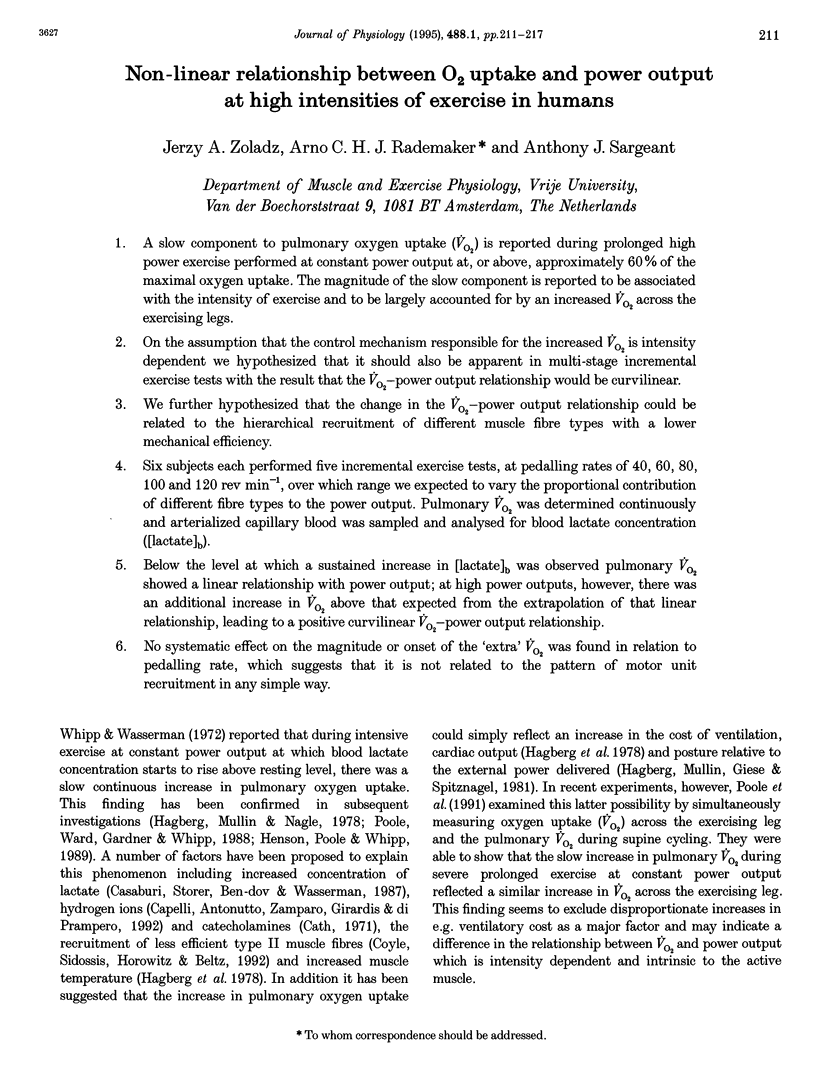
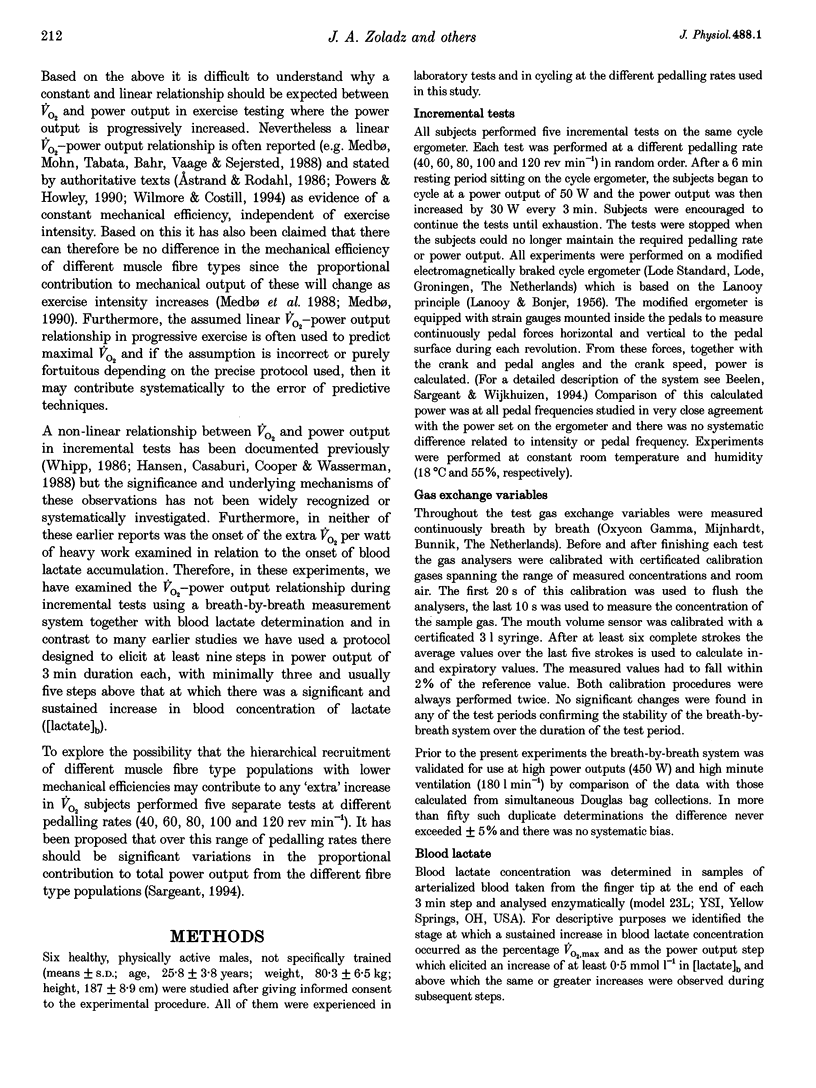
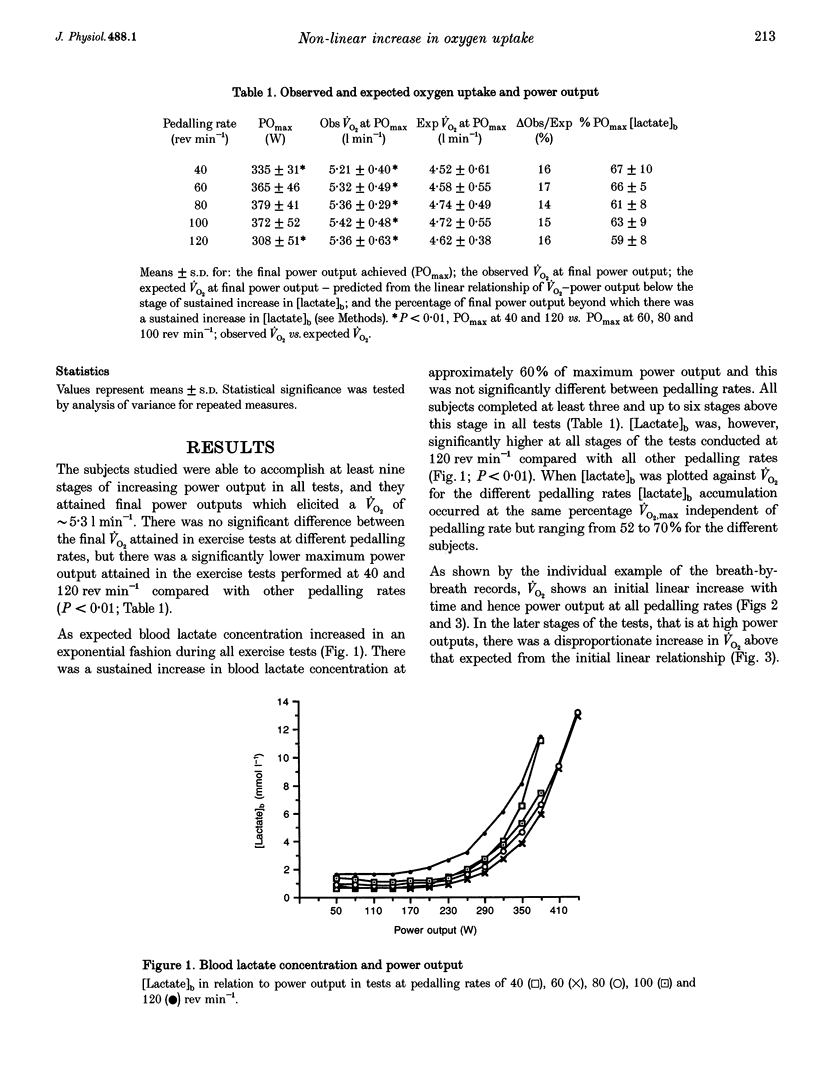
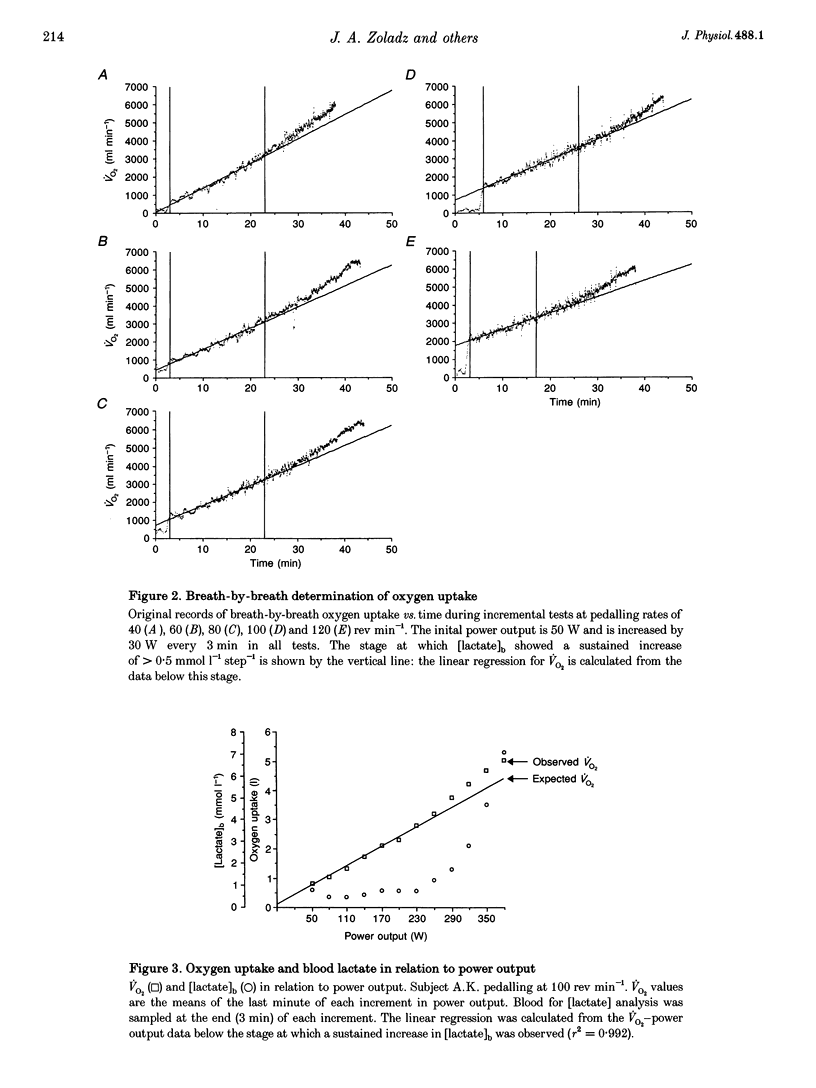
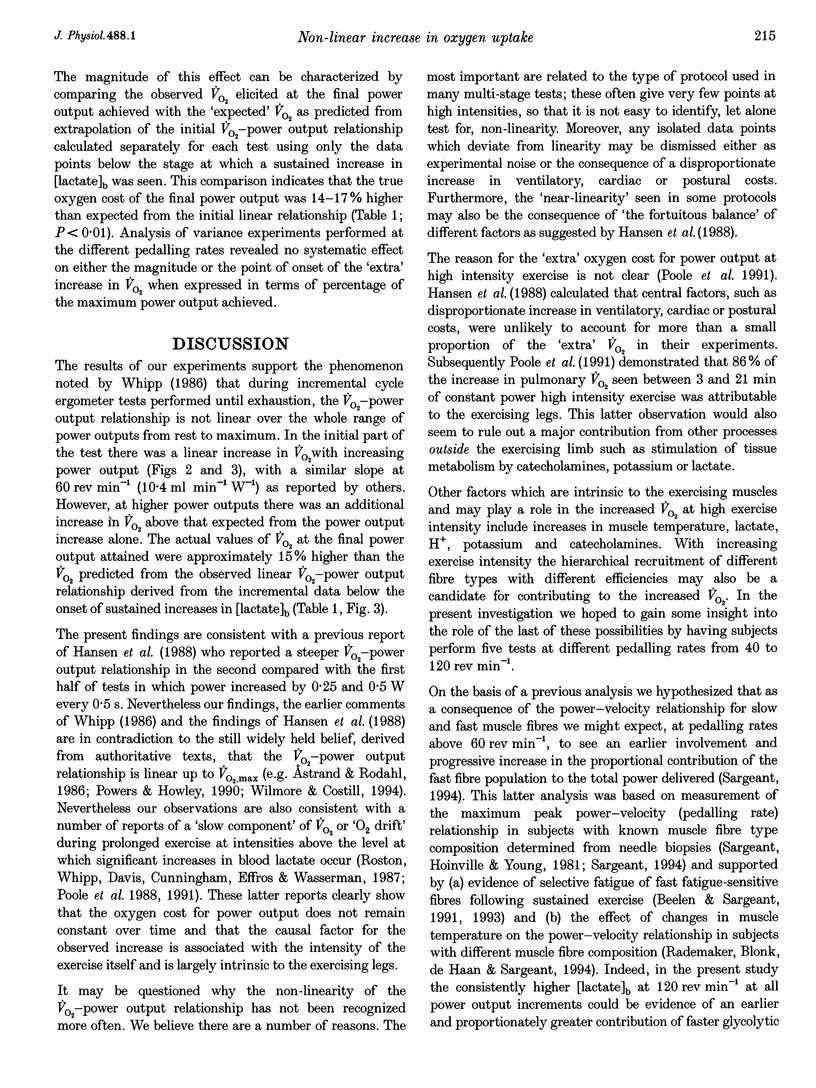
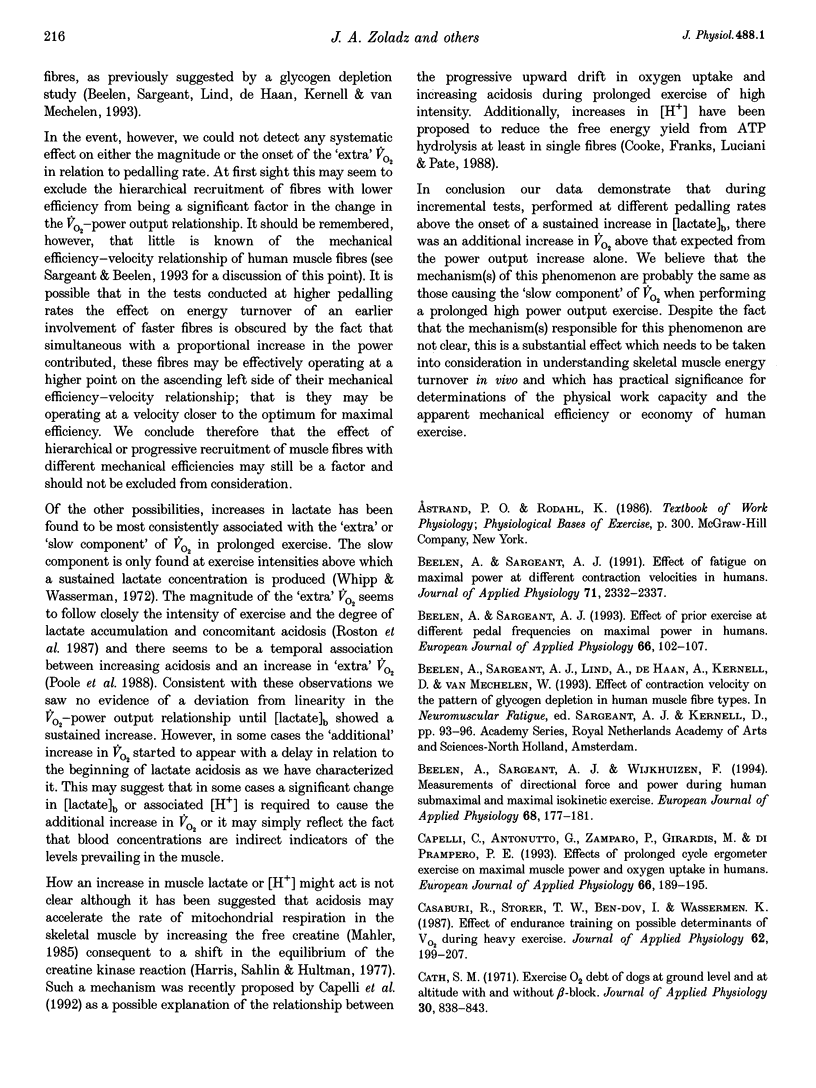
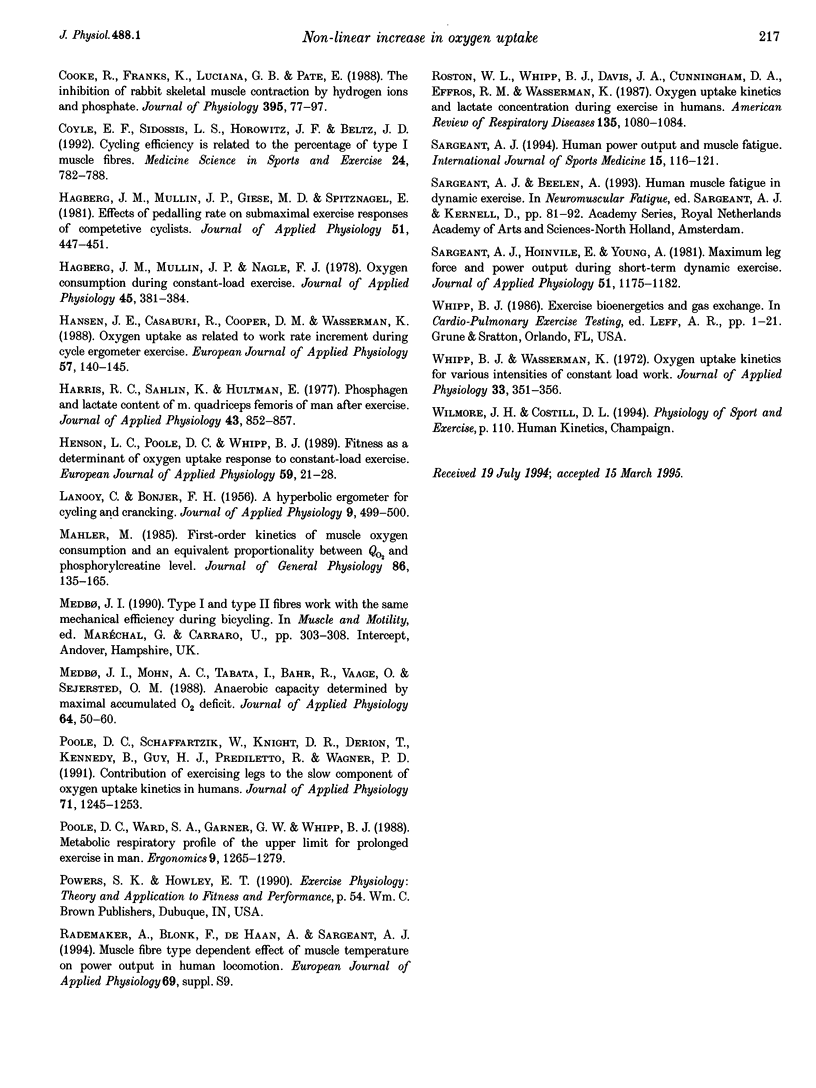
Selected References
These references are in PubMed. This may not be the complete list of references from this article.
- BONJER F. H., LANOOY C. A hyperbolic ergometer for cycling and cranking. J Appl Physiol. 1956 Nov;9(3):499–500. doi: 10.1152/jappl.1956.9.3.499. [DOI] [PubMed] [Google Scholar]
- Beelen A., Sargeant A. J. Effect of fatigue on maximal power output at different contraction velocities in humans. J Appl Physiol (1985) 1991 Dec;71(6):2332–2337. doi: 10.1152/jappl.1991.71.6.2332. [DOI] [PubMed] [Google Scholar]
- Beelen A., Sargeant A. J. Effect of prior exercise at different pedalling frequencies on maximal power in humans. Eur J Appl Physiol Occup Physiol. 1993;66(2):102–107. doi: 10.1007/BF01427049. [DOI] [PubMed] [Google Scholar]
- Beelen A., Sargeant A. J., Wijkhuizen F. Measurement of directional force and power during human submaximal and maximal isokinetic exercise. Eur J Appl Physiol Occup Physiol. 1994;68(2):177–181. doi: 10.1007/BF00244032. [DOI] [PubMed] [Google Scholar]
- Cain S. M. Exercise O2 debts of dogs at ground level and at altitude with and without beta-block. J Appl Physiol. 1971 Jun;30(6):838–843. doi: 10.1152/jappl.1971.30.6.838. [DOI] [PubMed] [Google Scholar]
- Capelli C., Antonutto G., Zamparo P., Girardis M., di Prampero P. E. Effects of prolonged cycle ergometer exercise on maximal muscle power and oxygen uptake in humans. Eur J Appl Physiol Occup Physiol. 1993;66(3):189–195. doi: 10.1007/BF00235092. [DOI] [PubMed] [Google Scholar]
- Casaburi R., Storer T. W., Ben-Dov I., Wasserman K. Effect of endurance training on possible determinants of VO2 during heavy exercise. J Appl Physiol (1985) 1987 Jan;62(1):199–207. doi: 10.1152/jappl.1987.62.1.199. [DOI] [PubMed] [Google Scholar]
- Cooke R., Franks K., Luciani G. B., Pate E. The inhibition of rabbit skeletal muscle contraction by hydrogen ions and phosphate. J Physiol. 1988 Jan;395:77–97. doi: 10.1113/jphysiol.1988.sp016909. [DOI] [PMC free article] [PubMed] [Google Scholar]
- Coyle E. F., Sidossis L. S., Horowitz J. F., Beltz J. D. Cycling efficiency is related to the percentage of type I muscle fibers. Med Sci Sports Exerc. 1992 Jul;24(7):782–788. [PubMed] [Google Scholar]
- Hagberg J. M., Mullin J. P., Giese M. D., Spitznagel E. Effect of pedaling rate on submaximal exercise responses of competitive cyclists. J Appl Physiol Respir Environ Exerc Physiol. 1981 Aug;51(2):447–451. doi: 10.1152/jappl.1981.51.2.447. [DOI] [PubMed] [Google Scholar]
- Hagberg J. M., Mullin J. P., Nagle F. J. Oxygen consumption during constant-load exercise. J Appl Physiol Respir Environ Exerc Physiol. 1978 Sep;45(3):381–384. doi: 10.1152/jappl.1978.45.3.381. [DOI] [PubMed] [Google Scholar]
- Hansen J. E., Casaburi R., Cooper D. M., Wasserman K. Oxygen uptake as related to work rate increment during cycle ergometer exercise. Eur J Appl Physiol Occup Physiol. 1988;57(2):140–145. doi: 10.1007/BF00640653. [DOI] [PubMed] [Google Scholar]
- Harris R. C., Sahlin K., Hultman E. Phosphagen and lactate contents of m. quadriceps femoris of man after exercise. J Appl Physiol Respir Environ Exerc Physiol. 1977 Nov;43(5):852–857. doi: 10.1152/jappl.1977.43.5.852. [DOI] [PubMed] [Google Scholar]
- Henson L. C., Poole D. C., Whipp B. J. Fitness as a determinant of oxygen uptake response to constant-load exercise. Eur J Appl Physiol Occup Physiol. 1989;59(1-2):21–28. doi: 10.1007/BF02396575. [DOI] [PubMed] [Google Scholar]
- Mahler M. First-order kinetics of muscle oxygen consumption, and an equivalent proportionality between QO2 and phosphorylcreatine level. Implications for the control of respiration. J Gen Physiol. 1985 Jul;86(1):135–165. doi: 10.1085/jgp.86.1.135. [DOI] [PMC free article] [PubMed] [Google Scholar]
- Medbø J. I., Mohn A. C., Tabata I., Bahr R., Vaage O., Sejersted O. M. Anaerobic capacity determined by maximal accumulated O2 deficit. J Appl Physiol (1985) 1988 Jan;64(1):50–60. doi: 10.1152/jappl.1988.64.1.50. [DOI] [PubMed] [Google Scholar]
- Poole D. C., Schaffartzik W., Knight D. R., Derion T., Kennedy B., Guy H. J., Prediletto R., Wagner P. D. Contribution of exercising legs to the slow component of oxygen uptake kinetics in humans. J Appl Physiol (1985) 1991 Oct;71(4):1245–1260. doi: 10.1152/jappl.1991.71.4.1245. [DOI] [PubMed] [Google Scholar]
- Poole D. C., Ward S. A., Gardner G. W., Whipp B. J. Metabolic and respiratory profile of the upper limit for prolonged exercise in man. Ergonomics. 1988 Sep;31(9):1265–1279. doi: 10.1080/00140138808966766. [DOI] [PubMed] [Google Scholar]
- Roston W. L., Whipp B. J., Davis J. A., Cunningham D. A., Effros R. M., Wasserman K. Oxygen uptake kinetics and lactate concentration during exercise in humans. Am Rev Respir Dis. 1987 May;135(5):1080–1084. doi: 10.1164/arrd.1987.135.5.1080. [DOI] [PubMed] [Google Scholar]
- Sargeant A. J., Hoinville E., Young A. Maximum leg force and power output during short-term dynamic exercise. J Appl Physiol Respir Environ Exerc Physiol. 1981 Nov;51(5):1175–1182. doi: 10.1152/jappl.1981.51.5.1175. [DOI] [PubMed] [Google Scholar]
- Sargeant A. J. Human power output and muscle fatigue. Int J Sports Med. 1994 Apr;15(3):116–121. doi: 10.1055/s-2007-1021031. [DOI] [PubMed] [Google Scholar]
- Whipp B. J., Wasserman K. Oxygen uptake kinetics for various intensities of constant-load work. J Appl Physiol. 1972 Sep;33(3):351–356. doi: 10.1152/jappl.1972.33.3.351. [DOI] [PubMed] [Google Scholar]


